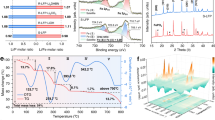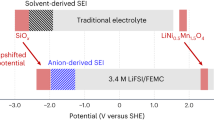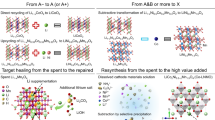Abstract
The continued market growth for electric vehicles globally is accelerating the transformational shift to a low-carbon transportation future. However, the sustainability of this transition hinges to a large extent on the management of waste, including end-of-life batteries where strategic elements such as lithium (Li) and cobalt (Co) are present. Different from the existing pyrometallurgical and hydrometallurgical recycling methods that involve heavy energy inputs and the use of hazardous chemicals, here we show a feasible single-step process that not only reclaims lithium cobalt oxide (LiCoO2) from waste Li-ion batteries but also upgrades it to a cathode with enhanced electrochemical properties. Our recycling process is based on a direct reaction between spent LiCoO2 and added mixture of Al2O3, MgO and Li2CO3, during which the Li vacancies aid the diffusion of Al and Mg to yield dual-doped LiCoO2. The upgraded LiCoO2 cathode possesses even better structural stability and sustains 300 cycles retaining 79.7% of its initial capacity at a voltage of 4.6 V. As evidenced by the technoeconomic analysis, the current circularity approach exhibits cost benefits and could catalyse further progress in the upcycling of different materials for batteries.
This is a preview of subscription content, access via your institution
Access options
Access Nature and 54 other Nature Portfolio journals
Get Nature+, our best-value online-access subscription
$29.99 / 30 days
cancel any time
Subscribe to this journal
Receive 12 digital issues and online access to articles
$119.00 per year
only $9.92 per issue
Buy this article
- Purchase on Springer Link
- Instant access to full article PDF
Prices may be subject to local taxes which are calculated during checkout






Similar content being viewed by others
Data availability
All data supporting the research in this paper are available in the main text and Supplementary Information, and original data can be obtained through reasonable requests from corresponding authors.
References
Larcher, D. & Tarascon, J.-M. Towards greener and more sustainable batteries for electrical energy storage. Nat. Chem. 7, 19–29 (2015).
Bauer, C. et al. Charging sustainable batteries. Nat. Sustain. 5, 176–178 (2022).
Li, J. et al. Structural origin of the high-voltage instability of lithium cobalt oxide. Nat. Nanotechnol. 16, 599–605 (2021).
Wang, K. et al. Recent advances and historical developments of high voltage lithium cobalt oxide materials for rechargeable Li-ion batteries. J. Power Sources 460, 228062 (2020).
Qian, J. et al. Electrochemical surface passivation of LiCoO2 particles at ultrahigh voltage and its applications in lithium-based batteries. Nat. Commun. 9, 4918 (2018).
Li, Z. et al. Multi-scale stabilization of high-voltage LiCoO2 enabled by nanoscale solid electrolyte coating. Energy Storage Mater. 29, 71–77 (2020).
Liu, Q. et al. Approaching the capacity limit of lithium cobalt oxide in lithium ion batteries via lanthanum and aluminium doping. Nat. Energy 3, 936–943 (2018).
Hong, Y.-S. et al. Hierarchical defect engineering for LiCoO2 through low-solubility trace element doping. Chem 6, 2759–2769 (2020).
Zhang, J.-N. et al. Trace doping of multiple elements enables stable battery cycling of LiCoO2 at 4.6 V. Nat. Energy 4, 594–603 (2019).
Wang, J. et al. Direct conversion of degraded LiCoO2 cathode materials into high-performance LiCoO2: a closed-loop green recycling strategy for spent lithium-ion batteries. Energy Storage Mater. 45, 768–776 (2022).
Harper, G. et al. Recycling lithium-ion batteries from electric vehicles. Nature 575, 75–86 (2019).
Piątek, J. et al. Sustainable Li‐ion batteries: chemistry and recycling. Adv. Energy Mater. 11, 2003456 (2021).
Yang, Y. et al. On the sustainability of lithium ion battery industry—a review and perspective. Energy Storage Mater. 36, 186–212 (2021).
Wang, J. et al. Direct and green repairing of degraded LiCoO2 for reuse in lithium-ion batteries. Natl Sci. Rev. 9, nwac097 (2022).
Makuza, B., Tian, Q., Guo, X., Chattopadhyay, K. & Yu, D. Pyrometallurgical options for recycling spent lithium-ion batteries: a comprehensive review. J. Power Sources 491, 229622 (2021).
Yao, Y. et al. Hydrometallurgical processes for recycling spent lithium-ion batteries: a critical review. ACS Sustain. Chem. Eng. 6, 13611–13627 (2018).
Shi, Y., Chen, G. & Chen, Z. Effective regeneration of LiCoO2 from spent lithium-ion batteries: a direct approach towards high-performance active particles. Green. Chem. 20, 851–862 (2018).
Meng, X. et al. Recycling of LiNi1/3Co1/3Mn1/3O2 cathode materials from spent lithium-ion batteries using mechanochemical activation and solid-state sintering. Waste Manage. 84, 54–63 (2019).
Gao, Y., Li, Y., Li, J., Xie, H. & Chen, Y. Direct recovery of LiCoO2 from the recycled lithium-ion batteries via structure restoration. J. Alloys Compd. 845, 156234 (2020).
Shim, J.-H., Lee, S. & Park, S. S. Effects of MgO coating on the structural and electrochemical characteristics of LiCoO2 as cathode materials for lithium ion battery. Chem. Mater. 26, 2537–2543 (2014).
Kong, W. et al. Tailoring Co3d and O2p band centers to inhibit oxygen escape for stable 4.6 V LiCoO2 cathodes. Angew. Chem. Int. Ed. 60, 27102–27112 (2021).
Nithya, C., Thirunakaran, R., Sivashanmugam, A. & Gopukumar, S. High-performing LiMgxCuyCo1–x–yO2 cathode material for lithium rechargeable batteries. ACS Appl. Mater. Interfaces 4, 4040–4046 (2012).
Huang, Y. et al. Mg‐Pillared LiCoO2: towards stable cycling at 4.6 V. Angew. Chem. Int. Ed. 133, 4732–4738 (2021).
Kong, W. et al. Unraveling the distinct roles of Mg occupation on Li or Co sites on high-voltage LiCoO2. J. Electrochem. Soc. 168, 030528 (2021).
Oh, P. et al. Recent advances and prospects of atomic substitution on layered positive materials for lithium‐ion battery. Adv. Energy Mater. 11, 2003197 (2021).
Fan, E. et al. Resolving the structural defects of spent Li1−xCoO2 particles to directly reconstruct high voltage performance cathode for lithium‐ion batteries. Small Methods 5, 2100672 (2021).
Fei, Z. et al. Dual-function regeneration of waste lithium cobalt oxide for stable high voltage cycle performance. ACS Sustain. Chem. Eng. 9, 11194–11203 (2021).
Wang, L. et al. A novel bifunctional self‐stabilized strategy enabling 4.6 V LiCoO2 with excellent long‐term cyclability and high‐rate capability. Adv. Sci. 6, 1900355 (2019).
Jia, K. et al. Suppressed lattice oxygen release via Ni/Mn doping from spent LiNi0.5Mn0.3Co0.2O2 toward high-energy layered-oxide cathodes. Nano Lett. 22, 8372–8380 (2022).
Qin, C., Jiang, Y., Yan, P. & Sui, M. Revealing the minor Li-ion blocking effect of LiCoO2 surface phase transition layer. J. Power Sources 460, 228126 (2020).
Hirooka, M. et al. Improvement of float charge durability for LiCoO2 electrodes under high voltage and storage temperature by suppressing O1-phase transition. J. Power Sources 463, 228127 (2020).
Zhou, S. et al. Collaborative regeneration of structural evolution for high-performance of LiCoO2 materials from spent lithium-ion batteries. ACS Appl. Energy Mater. 4, 12677–12687 (2021).
Shim, J.-H., Cho, N.-H. & Lee, S. Synthesis and characterization of Mg2TiO4-coated LiCoO2 as a cathode material for lithium ion batteries. Electrochim. Acta 243, 162–169 (2017).
Hu, B. et al. A multifunctional manipulation to stabilize oxygen redox and phase transition in 4.6 V high-voltage LiCoO2 with sXAS and EPR studies. J. Power Sources 516, 230661 (2021).
Wang, Z. et al. Mg doping and zirconium oxyfluoride coating co-modification to enhance the high-voltage performance of LiCoO2 for lithium ion battery. J. Alloys Compd. 621, 212–219 (2015).
Van Elp, J. et al. Electronic structure of CoO, Li-doped CoO, and LiCoO2. Phys. Rev. B 44, 6090 (1991).
Ganesh, K. S., Wang, B., Kim, J.-S. & Zhu, B. Ionic conducting properties and fuel cell performance developed by band structures. J. Phys. Chem. C 123, 8569–8577 (2019).
Kresse, G. & Furthmüller, J. Efficient iterative schemes for ab initio total-energy calculations using a plane-wave basis set. Phys. Rev. B 54, 11169 (1996).
Perdew, J. P., Burke, K. & Ernzerhof, M. Generalized gradient approximation made simple. Phys. Rev. Lett. 77, 3865 (1996).
Kresse, G. & Joubert, D. From ultrasoft pseudopotentials to the projector augmented-wave method. Phys. Rev. B 59, 1758 (1999).
Blöchl, P. E. Projector augmented-wave method. Phys. Rev. B 50, 17953 (1994).
Grimme, S., Antony, J., Ehrlich, S. & Krieg, H. A consistent and accurate ab initio parametrization of density functional dispersion correction (DFT-D) for the 94 elements H-Pu. J. Chem. Phys. 132, 154104 (2010).
Henkelman, G., Uberuaga, B. P. & Jónsson, H. A climbing image nudged elastic band method for finding saddle points and minimum energy paths. J. Chem. Phys. 113, 9901–9904 (2000).
Acknowledgements
G.Z. appreciates support from the National Key Research and Development Program of China (2019YFA0705700), Joint Funds of the National Natural Science Foundation of China (U21A20174), Guangdong Innovative and Entrepreneurial Research Team Program (2021ZT09L197), Shenzhen Science and Technology Program (KQTD20210811090112002), the Start-up Funds and Interdisciplinary Research and Innovation Fund of Tsinghua Shenzhen International Graduate School. G.Z. and J.W. appreciate support from Qinhe Energy Conservation and Environmental Protection Group Co., Ltd (no. QHHB-20210405).
Author information
Authors and Affiliations
Contributions
All authors contributed to this work. J.W. completed a major part of the experiments and drafted the original version of the manuscript. K.J. and J.M. helped perform some of the experiments and provided extensive suggestions for revisions of the original manuscript. Z.L., G.Z. and H.-M.C. discussed together and proposed the concepts of this paper and made extensive revisions to the original manuscript. Z.Z., Y.Z. and B.L. assisted in the design of some test methods and materials characterization.
Corresponding authors
Ethics declarations
Competing interests
The authors declare no competing interests.
Peer review
Peer review information
Nature Sustainability thanks Lei Pan, Gavin Harper, Lianqi Zhang and the other, anonymous, reviewer(s) for their contribution to the peer review of this work.
Additional information
Publisher’s note Springer Nature remains neutral with regard to jurisdictional claims in published maps and institutional affiliations.
Supplementary information
Supplementary Information
Supplementary Figs. 1–27, Tables 1–6 and Text.
Rights and permissions
Springer Nature or its licensor (e.g. a society or other partner) holds exclusive rights to this article under a publishing agreement with the author(s) or other rightsholder(s); author self-archiving of the accepted manuscript version of this article is solely governed by the terms of such publishing agreement and applicable law.
About this article
Cite this article
Wang, J., Jia, K., Ma, J. et al. Sustainable upcycling of spent LiCoO2 to an ultra-stable battery cathode at high voltage. Nat Sustain 6, 797–805 (2023). https://doi.org/10.1038/s41893-023-01094-9
Received:
Accepted:
Published:
Issue Date:
DOI: https://doi.org/10.1038/s41893-023-01094-9
This article is cited by
-
Subtractive transformation of cathode materials in spent Li-ion batteries to a low-cobalt 5 V-class cathode material
Nature Communications (2024)
-
Water-in-polymer electrolyte with a wide electrochemical window and recyclability
Nature Sustainability (2024)
-
Grave-to-cradle photothermal upcycling of waste polyesters over spent LiCoO2
Nature Communications (2024)
-
Upcycle for enhanced performance
Nature Sustainability (2023)
-
Defective oxygen inert phase stabilized high-voltage nickel-rich cathode for high-energy lithium-ion batteries
Nature Communications (2023)



